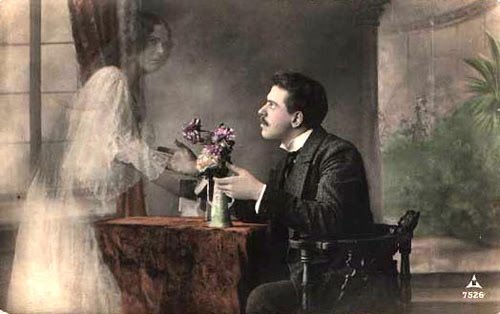Paranormal Adventures ~ In order to honor, respect and validate the lives of those whom we cannot always see and hear! These are my haunting adventures I'm on, have been on and plan on doing. I hope you enjoy and it enlightens you!
Ghost Lover

Friday, May 4, 2012
Many mysterious faces and figures in this photo of Hitler's bunker
After reading the article listed below and viewing the unpublished photos, I was drawn to one particular photo which I am sharing here on my blog. My eyes were immediately centered on the figure of a lady on what appears to be a door, at first I thought it was a bed upturned. I have yet to find any reference to this photo being odd, eerie or paranormal. Therefore, I suppose it's my interest to share this with others so they may view, analyze and share if they so care to.
* Quoted from an article posted on this website: http://life.time.com/history/inside-hitlers-bunker-rare-and-unpublished-photos/#2
* In April 1945, as Russian and German troops fought — savagely, street by street — for control of the German capital, it became increasingly clear that the Allies would win the war in Europe. Not long after the two-week battle ended, 33-year-old LIFE photographer William Vandivert was on the scene, photographing Berlin’s devastated landscape.
* Between August 1940 and March 1945 American, RAF and Soviet bombers launched more than 350 air strikes on Berlin; tens of thousands of civilians were killed, and countless buildings — apartment buildings, government offices, military installations — were obliterated. Vandivert, LIFE reported, “found almost every famous building [in Berlin] a shambles. In the center of town GIs could walk for blocks and see no living thing, hear nothing but the stillness of death, smell nothing but the stench of death.”
* Hundreds of thousands perished in the Battle of Berlin — including untold numbers of civilian men, women and children — while countless more were left homeless in the ruins. But it was two particular deaths, those of Adolf Hitler and his longtime companion and (briefly) wife Eva Braun, in a sordid underground bunker on April 30, 1945, that signaled the true, final fall of the Third Reich.
* Vandivert was the first Western photographer to gain access to Hitler’s Führerbunker, or “shelter for the leader,” after the fall of Berlin, and a handful of his pictures of the bunker and the ruined city were published in LIFE magazine in July 1945. A few of those images are republished here; most of the pictures in this gallery, however, were never published in LIFE and vividly illustrate the surreal, disturbing scenes Vandivert encountered in the bunker and in the streets of the vanquished city beyond the bunker’s walls.
* In his typed notes to his editors in New York, Vandivert described in detail what he saw. For example, of the sixth slide in this gallery, he wrote, “Pix of [correspondents] looking at sofa where Hitler and Eva shot themselves. Note bloodstains on arm of soaf [sic] where Eva bled. She was seated at far end … Hitler sat in middle and fell forward, did not bleed on sofa. This is in Hitler’s sitting room.” Remarkable stuff — but, it turns out, it’s only about half right. Historians are now quite certain that Braun committed suicide by biting a cyanide capsule, rather than by gunshot — meaning the bloodstains on the couch might well be Hitler’s after all.
A NOTE ON THE PHOTOGRAPHER: William Vandivert — who at 6 ft. 5 in. held the distinction of being the tallest photographer on staff — shot for LIFE from the late 1930s through the late ’40s. In 1947 he joined Robert Capa, Henri Cartier-Bresson, George Rodger and David “Chim” Seymour in founding the legendary Magnum photo agency. (Rita Vandivert, his wife, served as Magnum’s first president.) William Vandivert died in 1992.
Read more: http://life.time.com/history/inside-hitlers-bunker-rare-and-unpublished-photos/#ixzz1tw5UmyR8
Subscribe to:
Post Comments (Atom)

Click on the photo to see it closer.
ReplyDelete